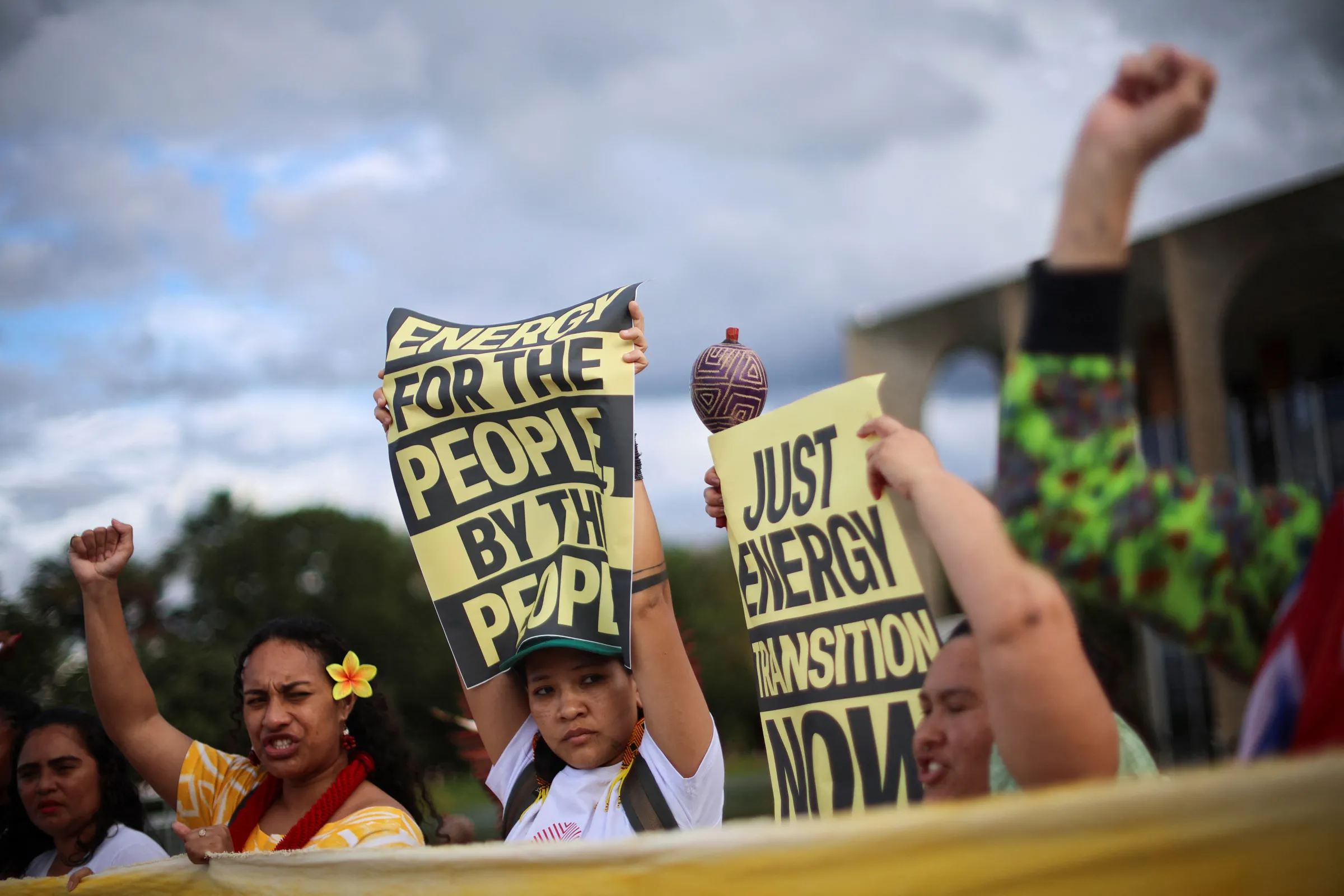Article 6 risks enabling a new kind of greenwashing.
Article 6: Climate tool or trap?
Opinion

Opinion
Activists hold signs during a performance and protest by Brazilian artist and activist Mundano, which asks for a response to the letter sent by the Terra Livre (Free Land) Indigenous movement to the presidency of COP30, in front of Itamaraty in Brasilia, Brazil April 15, 2025. REUTERS/Adriano Machado
Unless governments act fast to tighten rules on carbon credits, Article 6 could become a dangerous loophole that stalls progress
Injy Johnstone is a research fellow in Net-Zero Aligned Offsetting at the University of Oxford.
As COP30 in Brazil approaches this year, a fault line is emerging in global climate cooperation: the use, and potential misuse, of Article 6 of the Paris Agreement.
Instead of raising ambition and driving deeper carbon cuts, Article 6 risks enabling a new kind of greenwashing: one where countries can ostensibly meet their carbon-cutting pledges on paper while delaying tangible, real-world action.
Article 6, as shown in this new infographic from the Energy & Climate Intelligence Unit, allows countries to cooperate internationally to meet their Nationally Determined Contributions (NDCs), including through carbon markets that trade ‘mitigation outcomes’ (typically emission reductions or removals) across borders.
For example, if Country A overdelivers on afforestation, Country B can buy this mitigation outcome and count it towards its own NDC. Done right, such cooperation can help countries go further, faster — cutting emissions more efficiently and ambitiously together than they could independently.
But unless governments act swiftly to tighten the rules agreed at COP29 in Baku, Article 6 could become a dangerous loophole that weakens rather than accelerates progress.
Confusing reductions and removals
A core problem is that, in its current framing, Article 6 does not sufficiently distinguish between emissions reductions (for example installing solar panels) and removals (including direct air capture and reforestation).
To stop global heating we must slash emissions as fast as possible, before removing ‘residual’ carbon dioxide to reach net zero — and sustaining that balance over time.
Without a clear separation, however, countries could use low-quality carbon credits — often from cheap emissions avoidance projects — to offset rising domestic emissions. Some countries are already planning to increase emissions while relying on Article 6 trading to meet their NDCs.
Singapore, for example, expects its emissions to grow, peaking in 2028, even as it scales up Article 6-based carbon credit purchases.
If left unchecked, this blind spot could enable industrial and international-scale greenwashing of NDCs, deepening the ‘credibility crisis’ that has long plagued the voluntary carbon market (VCM).
A market dominated by avoidance credits
Currently over 90% of issued carbon credits in the VCM come from emission avoidance or reduction projects — such as clean energy or efficient cookstoves.
Historically, only about 3% of carbon credits have come from removal-only projects like afforestation or reforestation.
Only a derisory fraction of credits represents durable removals — those that aim to permanently store carbon underground, through methods like Direct Air Carbon Capture and Storage (DACCS) or Bioenergy with Carbon Capture and Storage (BECCS).
Insights into the Article 6 pipeline suggest it is vulnerable to the same patterns that have long plagued the international carbon market, especially the flood of low-cost and low-quality avoidance and reduction credits.
This dynamic risks allowing countries to claim progress while actual emissions remain unchanged — or even increase.
The Net Zero Tracker, the world's only register of mitigation targets and strategies from all nations, large cities and companies, and major sub-national regions, reveals a gaping accountability gap on the use of carbon credits. Currently only 16 national governments have climate targets that include separate targets for carbon removal.
The path forward: prioritising durable removals
To fix this, governments and companies should:
1. Set separate targets: Climate strategies should distinguish between emissions reductions (nature-based removals such as reforestation) and durable geological-based removals, for example through DACCS. Without separation, countries can misuse cheaper, low-quality mitigation outcomes.
2. Scale up durable Carbon Dioxide Removal (CDR): Investment in high-integrity removal solutions like biochar, BECCS, and DACCS, must increase to balance out hard-to-reduce emissions. Durable removals are vital, but currently account for only a tiny fraction of global carbon crediting activity.
3. Reform Article 6 rules: Durable removals should be the standard for crediting under Article 6, while nature-based removals and emission reductions should be managed under separate frameworks — such as Article 5 , which is focused on providing finance for nature, and Article 9 on climate finance.
A net zero-aligned path forward
If Article 6 becomes a tool for cheap, low-integrity offsets, it will severely undermine trust in net zero. Worse still, it will lock in higher levels of heating — making global temperature goals harder, if not impossible, to achieve.
Article 6 was designed to make climate targets more ambitious, and their implementation faster, and more affordable. It must not become a backdoor for weak pledges and fake progress. We cannot let countries “NDC wash” as we have seen corporations greenwash.
The world’s governments face a choice: reform Article 6 to ensure it drives high-integrity, durable climate action, or risk turning one of the Paris Agreement’s most powerful tools into its Achilles heel.
The credibility of global climate cooperation depends on getting it right.
Any views expressed in this opinion piece are those of the author and not of Context or the Thomson Reuters Foundation.
Tags
- Adaptation
- Energy efficiency
- Net-zero
- Climate policy
- Carbon offsetting
- Climate and health
Go Deeper
Related
Latest on Context
- 1
- 2
- 3
- 4
- 5
- 6
Most Read
- 1
- 2
- 3
- 4
- 5

















